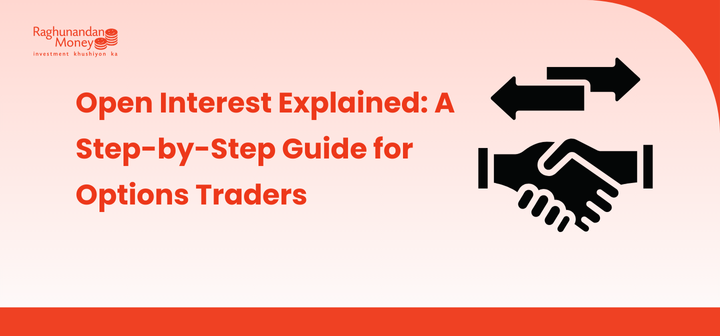Open Interest Explained: A Step-by-Step Guide for Options Traders
Post Date : March 31, 2025

Open Interest Explained: A Step-by-Step Guide for Options Traders
Disclaimer: This content is solely for educational purposes. The securities/investments quoted here are not recommendatory.
Open Interest (OI) in options trading is a key indicator that tracks the total number of active contracts in the market. It provides critical insights into liquidity, market sentiment, and the level of participation, offering traders valuable data for trend analysis and strategy formulation.
In this article, we’ll dive deep into what open interest is, how it functions, and why it’s crucial for options traders. Additionally, we’ll explore the difference between open interest and trading volume, offer tips on how to analyze open interest data, and explain how to use this information in your trading strategies.
What is Open Interest in Options?
Open Interest refers to the total number of outstanding options or futures contracts that remain open or active in the market. These contracts have been traded but not yet settled or offset by closing transactions.
As new contracts are created, open interest rises, and when existing positions are closed, open interest decreases. Unlike trading volume, which merely counts the number of trades made, open interest reveals the number of active positions that are still open in the market.
Open interest is a vital market indicator that reveals how many traders are involved in a particular asset. A high open interest typically indicates a healthy level of activity and liquidity in the market.
How Does Open Interest Work?
In options trading, every contract involves a buyer and a seller. When a buyer opens a new position and a seller agrees to take the other side of that position, open interest increases by one contract. Conversely, when the buyer and seller close their positions, open interest decreases by one.
For example, let’s look at a hypothetical scenario involving three traders—Trader X, Trader Y, and Trader Z:
Day 1:
- Trader X buys two new contracts from Trader Y.
- Open Interest rises by two, as these are new contracts created.
Day 2:
- Trader X sells one of their contracts to Trader Z.
- Open Interest remains unchanged because no new contracts have been created, and the position is simply transferred.
Day 3:
- Trader Y closes their position by buying back one contract from Trader Z.
- Open Interest decreases by one because this transaction settles a previously active position.
By observing changes in open interest over time, traders can analyze the flow of money into or out of the market and identify potential trends.
Open Interest vs Trading Volume
Both open interest and trading volume provide valuable insights, but they measure different aspects:
| Key Elements |
Open Interest |
Trading Volume |
| Definition |
Total number of outstanding contracts |
Total contracts traded within a timeframe |
| Data Update Frequency |
Updated at the end of each trading day |
Updated throughout the trading day |
| Interpretation |
Indicates market participation and commitment |
Indicates buying/selling activity |
| Trend Analysis |
Rising open interest signals market interest, potentially indicating price trends |
High volume suggests active trading and often increased volatility |
Trading volume measures the total number of contracts traded during a specific period, while open interest shows the number of contracts that remain open, offering a deeper understanding of market participation.
The Importance of Open Interest in Trading
Open interest is vital for options traders for several reasons:
- Market Sentiment and Activity: Rising open interest suggests more participants are trading the option, typically aligning with active market sentiment. Conversely, falling open interest can indicate that traders are closing positions, signaling waning interest in the contract.
- Liquidity Indicator: High open interest typically means more liquidity in the market, making it easier for traders to buy or sell options. More liquidity also results in narrower bid-ask spreads, reducing transaction costs.
- Trend Confirmation: When open interest rises alongside price increases, it often confirms a bullish trend, indicating a strong market consensus in the upward price movement.
- Potential Reversal Signals: At extreme levels, high open interest may indicate overbought or oversold conditions, signaling a potential trend reversal.
How to Analyze Open Interest Data
Open interest analysis is an essential tool in assessing the strength and sustainability of trends.
By tracking changes in open interest, volume, and price, traders can identify various market conditions:
| Price |
Volume |
Open Interest |
Interpretation |
| Rising |
Rising |
Rising |
Bullish signal, strong market momentum |
| Rising |
Falling |
Falling |
Bearish signal, weakening uptrend |
| Falling |
Rising |
Rising |
Bearish signal, downtrend likely to continue |
| Falling |
Falling |
Falling |
Bullish signal, potential reversal upward |
By combining open interest trends with price movements, traders can better understand market dynamics, from confirming a trend to spotting a potential reversal.
How to Use Open Interest in Trading Strategies?
Traders can incorporate open interest data into their strategies in the following ways:
- Spotting Breakouts: If open interest and trading volume both rise as a stock breaks through key resistance levels, this confirms the breakout, suggesting the price may continue in that direction.
- Identifying Trend Reversals: Divergence between price movement and open interest can signal a reversal. For example, if the price hits new highs but open interest falls, it could indicate that fewer traders are backing the trend, signaling a potential reversal.
- Intraday Trading: For intraday traders, tracking open interest for specific options contracts helps identify institutional activity. Large positions in certain strikes may suggest institutional involvement, which is often referred to as “smart money.”
- Combining OI with Volume: The combination of open interest and trading volume gives valuable insights into liquidity and market sentiment. High volume and rising open interest can support a strong market trend, while low volume combined with high open interest may suggest a lack of market enthusiasm.
The Advantages of Monitoring Open Interest
Monitoring open interest offers several benefits:
- Better Market Timing: Open interest can help traders time their entries and exits by indicating the level of market sentiment.
- Enhanced Liquidity: Trading more liquid options with high open interest allows for easier entry and exit, reducing costs and slippage.
- Improved Trend Identification: Open interest trends can help traders distinguish between short-term fluctuations and long-term market trends.
- Lower Trading Risks: Using open interest as part of a broader market analysis helps reduce the risk of entering weak or less supported trades.
Key Takeaways
- Insight into Market Participation: Open interest shows how many outstanding contracts are in the market, indicating the level of interest in a specific asset.
- Liquidity Gauge: A high OI indicates better liquidity, which makes it easier to execute trades without substantial price impact.
- Trend Confirmation: Rising open interest in line with price movement confirms strong trends, while divergences may signal reversals.
- Effective Trade Timing: By analyzing open interest, traders can time their trades more effectively and align with broader market sentiment.
FAQs
- What happens if call Open Interest (OI) is high?
High call OI generally suggests bullish sentiment considering the price and volume of spot, as traders anticipate the underlying asset’s price to rise.
- Is open interest a bullish or bearish indicator?
Open interest itself is neutral. Rising OI with rising prices is bullish. Rising OI with falling prices may be bearish.
- How does open interest differ from trading volume?
Open interest tracks total outstanding contracts (long-term). Volume tracks short-term trading activity.
- Why is open interest important for options trading?
Open interest provides insights into market liquidity, trend strength, and sentiment. Rising OI often supports the current trend.
Need Help?
Contact RMoney at 0562-4266600 / 0562-7188900 or email askus@rmoneyindia.com

Stock Trading Now trade in ₹9 Per Order or ₹ 999 Per Month Plans.
Future & Options Access F&O contracts with advanced tools for hedging and speculation.
Currency Trading Trade in major currency pairs and manage forex exposure efficiently.
Commodity Trading Diversify Trading with MCX & NCDEX by Trading in Gold, Silver, Base Metals, Energy, and Agri Products.
Margin Trading Funding Boost your buying power with upto 5X, Buy now Pay Later
Algo Trading Back test, Paper Trade your logic & Automate your strategies with low-latency APIs.
Trading View Leverage Trading View charts and indicators integrated into your trading platform.
Advanced Options Trading Execute multi-leg option strategies with precision and insights.
Stock Lending & Borrowing Earn passive income by lending stocks securely through SLB.
Foreign Portfolio Investment Enable NRIs and FPIs to invest in Indian markets with ease and compliance.
IPO Invest in upcoming IPOs online with real-time tracking and instant allotment updates.
Direct Mutual Funds 0% Commissions by investing in more than +3500 Direct Mutual Fund Scheme.
Corporate FDRs Earn fixed returns with low-risk investments in high-rated corporate fixed deposits.
Stocks SIPs Build long-term wealth with systematic investment plans in top-performing stocks.
Bonds & NCDs Access secure, fixed-income investments through government and corporate bond offerings.
Depository Services Safely hold and manage your securities with seamless Demat and DP services with CDSL.
Journey Tracing our growth and milestones over time.
Mission & Vision Guided by purpose, driven by long-term vision.
Why RMoney Platform Smart, reliable platform for all investors' needs.
Management Experienced leadership driving strategic financial excellence.
Credentials Certified expertise with trusted industry recognition.
Press Release Latest company news, updates, and announcements.
Testimonials Real client stories sharing their success journeys.
7 Reasons to Invest Top benefits that make investing with us smart.
SEBI Registered Research Trusted insights backed by SEBI-compliant research.
Our Technology Advanced tools enabling efficient online trading.
Calculators Access a suite of smart tools to plan trades, margins, and returns effectively.
Margin Calculator Instantly check margin requirements for intraday and delivery trades.
MTF Calculator Calculate MTF funding cost upfront to ensure full transparency before placing a trade.
Brokerage Calculator Know your exact brokerage charges before placing any trade.
Market Place Explore curated investment products and trading tools in one convenient hub.
RMoney Gyan Enhance your market knowledge with expert blogs, videos, and tutorials.
Performance Tracker Track our research performance with full transparency using our performance tracker.
Feedback Share your suggestions or concerns to help us improve your experience.
Downloads Access important forms, software, and documents in one place.
Locate Us Find the nearest RMoney branch or service center quickly.
Escalation Matrix Resolve issues faster with our structured support escalation process.
Back Office Log in to view trade reports, ledger, and portfolio statements anytime.
Account Modification Update personal or bank details linked to your trading account.
Fund Transfer Transfer funds instantly online with quick limit updation to your trading account.
Bank Details View our registered bank account details for seamless transactions by NEFT, RTGS or IMPS.
How to Apply IPO Step-by-step guide to apply for IPOs using your trading account.
RMoney Quick Mobile App Trade on-the-go with our all-in-one mobile trading app.
RMoney Quick login Quickly access your trading account through the RMoney Quick web-based trading.
RMoney Rocket Web Version Experience powerful web-based trading with advanced tools for algo traders.
RMoney Rocket Mobile Version Trade anytime, anywhere with our feature-rich mobile trading platform.












